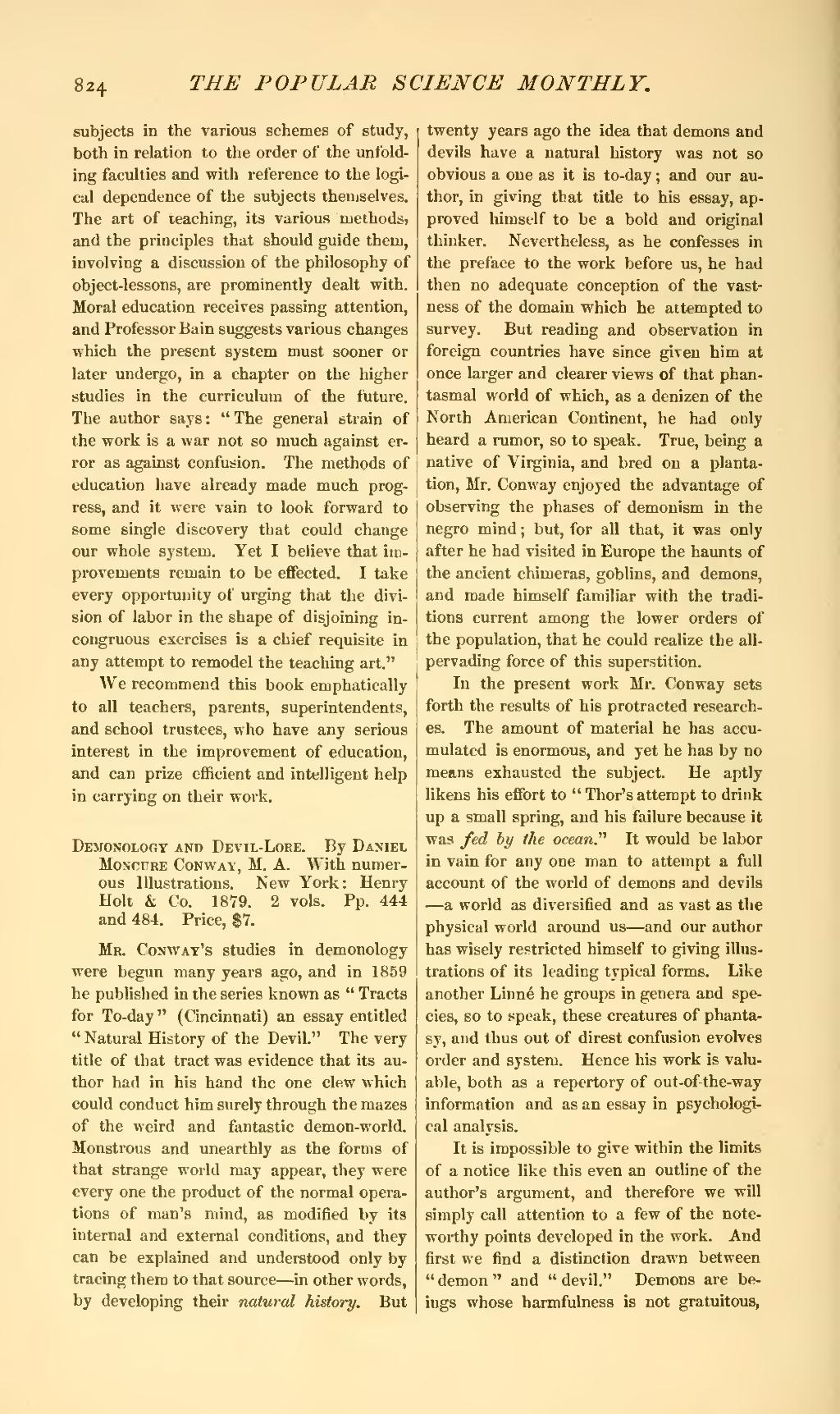subjects in the various schemes of study, both in relation to the order of the unfolding faculties and with reference to the logical dependence of the subjects themselves. The art of teaching, its various methods, and the principles that should guide them, involving a discussion of the philosophy of object-lessons, are prominently dealt with. Moral education receives passing attention, and Professor Bain suggests various changes which the present system must sooner or later undergo, in a chapter on the higher studies in the curriculum of the future. The author says: "The general strain of the work is a war not so much against error as against confusion. The methods of education have already made much progress, and it were vain to look forward to some single discovery that could change our whole system. Yet I believe that improvements remain to be effected. I take every opportunity of urging that the division of labor in the shape of disjoining incongruous exercises is a chief requisite in any attempt to remodel the teaching art."
We recommend this book emphatically to all teachers, parents, superintendents, and school trustees, who have any serious interest in the improvement of education, and can prize efficient and intelligent help in carrying on their work.
Demonology and Devil-Lore. By Daniel Moncure Conway, M. A. With numerous Illustrations. New York: Henry Holt & Co. 1879. 2 vols. Pp. 444 and 484. Price, $7.
Mr. Conway's studies in demonology were begun many years ago, and in 1859 he published in the series known as "Tracts for To-day" (Cincinnati) an essay entitled "Natural History of the Devil." The very title of that tract was evidence that its author had in his hand the one clew which could conduct him surely through the mazes of the weird and fantastic demon-world. Monstrous and unearthly as the forms of that strange world may appear, they were every one the product of the normal operations of man's mind, as modified by its internal and external conditions, and they can be explained and understood only by tracing them to that source—in other words, by developing their natural history. But twenty years ago the idea that demons and devils have a natural history was not so obvious a one as it is to-day; and our author, in giving that title to his essay, approved himself to be a bold and original thinker. Nevertheless, as he confesses in the preface to the work before us, he had then no adequate conception of the vastness of the domain which he attempted to survey. But reading and observation in foreign countries have since given him at once larger and clearer views of that phantasmal world of which, as a denizen of the North American Continent, he had only heard a rumor, so to speak. True, being a native of Virginia, and bred on a plantation, Mr. Conway enjoyed the advantage of observing the phases of demonism in the negro mind; but, for all that, it was only after he had visited in Europe the haunts of the ancient chimeras, goblins, and demons, and made himself familiar with the traditions current among the lower orders of the population, that he could realize the all pervading force of this superstition.
In the present work Mr. Conway sets forth the results of his protracted researches. The amount of material he has accumulated is enormous, and yet he has by no means exhausted the subject. He aptly likens his effort to "Thor's attempt to drink up a small spring, and his failure because it was fed by the ocean." It would be labor in vain for any one man to attempt a full account of the world of demons and devils—a world as diversified and as vast as the physical world around us—and our author has wisely restricted himself to giving illustrations of its leading typical forms. Like another Linné he groups in genera and species, so to speak, these creatures of phantasy, and thus out of direst confusion evolves order and system. Hence his work is valuable, both as a repertory of out-of the-way information and as an essay in psychological analysis.
It is impossible to give within the limits of a notice like this even an outline of the author's argument, and therefore we will simply call attention to a few of the noteworthy points developed in the work. And first we find a distinction drawn between "demon" and "devil." Demons are beings whose harmfulness is not gratuitous,
